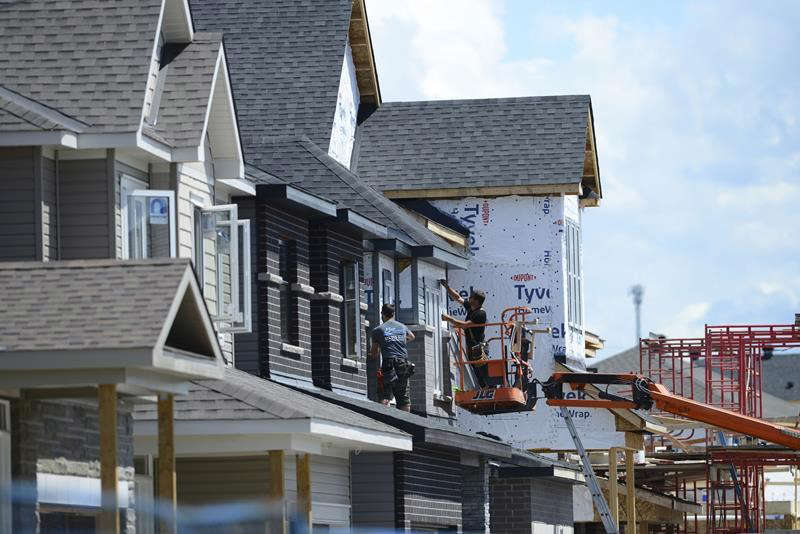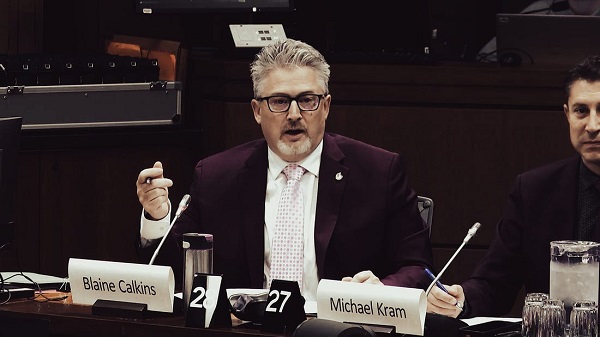Alberta
Addressing affordable homebuilding hurdles

A new Construction Codes Working Group will explore changes to construction codes to help address housing affordability.
As Alberta’s population continues to grow, so does the need for more housing options. That’s why the province has been working to reduce barriers and empower its housing partners to get more shovels in the ground, and get more houses built for Alberta families.
Alberta’s government continues to look at all options to build more homes. To further this work, a Construction Codes Working Group has been created to explore how Alberta’s construction codes can be improved to speed up development while still maintaining the required high quality and safety standards. The working group includes members from government, municipalities and the development community.
“We are leaving no stone unturned in our approach to increase housing options for Albertans. We have already collaborated to streamline some permitting processes, and by continuing to work together we will remove barriers standing in the way of housing options.”
“Albertans need more housing options as the population grows and it’s why we’ve been working to reduce barriers to housing construction. This working group is just another way that our government is working with housing partners and municipalities to accelerate homebuilding across the province.”
Using the expertise and experience of municipal and industry professionals, the Construction Codes Working Group will explore construction code amendments to accelerate the homebuilding process across the province and harness regulatory, municipal and industry expertise to tackle housing development complexities. Examples of code changes the working group may consider include those for secondary suites and single-stair apartments to make housing easier to build.
The Construction Codes Working Group will include representatives from Alberta’s government, the cities of Calgary and Edmonton, the Safety Codes Council, and the Building Industry and Land Development Association (BILD) Alberta. The Safety Codes Council will ensure safety codes officers are trained on any new codes, inspections or approval processes. BILD Alberta will give insight into market conditions and development challenges.
“In the face of unprecedented population growth, we need an ‘all hands-on deck’ approach to build more homes and meet the growing demand. The Construction Codes Working Group unites experts to streamline construction processes while maintaining top safety standards. I look forward to the insights and recommendations from this working group and am confident a collaborative approach will help deliver more housing options for Calgarians.”
“The City of Edmonton is proud to be a member of the new Construction Codes Working Group. As Edmonton continues to experience unprecedented growth and an increased demand for housing, we are eager to explore new and innovative ways to streamline the development process to ensure every Edmontonian has a home.”
On May 1, Alberta formally updated its provincial building and fire codes to align with national codes and allow for improved energy efficiency in housing and small buildings, while still emphasizing consumer affordability. The Construction Codes Working Group will build on this work to address additional pressures and development challenges found in Alberta’s housing market.
“As a member of the Construction Codes Working Group, BILD Alberta is proud to support the development of solutions that balance building code requirements with housing affordability. By collaborating with key stakeholders, we aim to identify innovative, practical changes that prioritize safety, efficiency and accessibility while addressing the pressing housing needs of Albertans.”
Quick facts
- The 2023 Alberta editions of the building and fire codes and the 2020 National Energy Code for Buildings came into force on May 1, 2024.
- The creation of the Construction Codes Working Group supports the goals of Alberta’s Housing Action Plan by looking at ways to cut red tape that are creating delays in affordable construction.
- The 2024 Accessibility Design Guide that was recently released includes detailed information and context to help the public and construction industry understand and apply the provincial building code’s accessibility requirements.
Related information
Alberta
Gondek’s exit as mayor marks a turning point for Calgary

This article supplied by Troy Media.
The mayor’s controversial term is over, but a divided conservative base may struggle to take the city in a new direction
Calgary’s mayoral election went to a recount. Independent candidate Jeromy Farkas won with 91,112 votes (26.1 per cent). Communities First candidate Sonya Sharp was a very close second with 90,496 votes (26 per cent) and controversial incumbent mayor Jyoti Gondek finished third with 71,502 votes (20.5 per cent).
Gondek’s embarrassing tenure as mayor is finally over.
Gondek’s list of political and economic failures in just a single four-year term could easily fill a few book chapters—and most likely will at some point. She declared a climate emergency on her first day as Calgary’s mayor that virtually no one in the city asked for. She supported a four per cent tax increase during the COVID-19 pandemic, when many individuals and families were struggling to make ends meet. She snubbed the Dec. 2023 menorah lighting during Hanukkah because speakers were going to voice support for Israel a mere two months after the country was attacked by the bloodthirsty terrorist organization Hamas. The
Calgary Party even accused her last month of spending over $112,000 in taxpayers’ money for an “image makeover and brand redevelopment” that could have benefited her re-election campaign.
How did Gondek get elected mayor of Calgary with 176,344 votes in 2021, which is over 45 per cent of the electorate?
“Calgary may be a historically right-of-centre city,” I wrote in a recent National Post column, “but it’s experienced some unusual voting behaviour when it comes to mayoral elections. Its last three mayors, Dave Bronconnier, Naheed Nenshi and Gondek, have all been Liberal or left-leaning. There have also been an assortment of other Liberal mayors in recent decades like Al Duerr and, before he had a political epiphany, Ralph Klein.”
In fairness, many Canadians used to support the concept of balancing their votes in federal, provincial and municipal politics. I knew of some colleagues, friends and family members, including my father, who used to vote for the federal Liberals and Ontario PCs. There were a couple who supported the federal PCs and Ontario Liberals in several instances. In the case of one of my late
grandfathers, he gave a stray vote for Brian Mulroney’s federal PCs, the NDP and even its predecessor, the Co-operative Commonwealth Federation.
That’s not the case any longer. The more typical voting pattern in modern Canada is one of ideological consistency. Conservatives vote for Conservative candidates, Liberals vote for Liberal candidates, and so forth. There are some rare exceptions in municipal politics, such as the late Toronto mayor Rob Ford’s populistconservative agenda winning over a very Liberal city in 2010. It doesn’t happen very often these days, however.
I’ve always been a proponent of ideological consistency. It’s a more logical way of voting instead of throwing away one vote (so to speak) for some perceived model of political balance. There will always be people who straddle the political fence and vote for different parties and candidates during an election. That’s their right in a democratic society, but it often creates a type of ideological inconsistency that doesn’t benefit voters, parties or the political process in general.
Calgary goes against the grain in municipal politics. The city’s political dynamics are very different today due to migration, immigration and the like. Support for fiscal and social conservatism may still exist in Alberta, but the urban-rural split has become more profound and meaningful than the historic left-right divide. This makes the task of winning Calgary in elections more difficult for today’s provincial and federal Conservatives, as well as right-leaning mayoral candidates.
That’s what we witnessed during the Oct. 20 municipal election. Some Calgary Conservatives believed that Farkas was a more progressive-oriented conservative or centrist with a less fiscally conservative plan and outlook for the city. They viewed Sharp, the leader of a right-leaning municipal party founded last December, as a small “c” conservative and much closer to their ideology. Conversely, some Calgary Conservatives felt that Farkas, and not Sharp, would be a better Conservative option for mayor because he seemed less ideological in his outlook.
When you put it all together, Conservatives in what used to be one of the most right-leaning cities in a historically right-leaning province couldn’t decide who was the best political option available to replace the left-wing incumbent mayor. Time will tell if they chose wisely.
Fortunately, the razor-thin vote split didn’t save Gondek’s political hide. Maybe ideological consistency will finally win the day in Calgary municipal politics once the recount has ended and the city’s next mayor has been certified.
Michael Taube is a political commentator, Troy Media syndicated columnist and former speechwriter for Prime Minister Stephen Harper. He holds a master’s degree in comparative politics from the London School of Economics, lending academic rigour to his political insights.
Troy Media empowers Canadian community news outlets by providing independent, insightful analysis and commentary. Our mission is to support local media in helping Canadians stay informed and engaged by delivering reliable content that strengthens community connections and deepens understanding across the country
Alberta
From Underdog to Top Broodmare

WATCH From Underdog to Top Broodmare (video)
Executive Producers Jeff Robillard (Horse Racing Alberta) and Mike Little (Shinelight Entertainment)
What began as an underdog story became a legacy of excellence. Crackers Hot Shot didn’t just race — she paved the way for future generations, and in doing so became one of the most influential producers the province has known.
The extraordinary journey of Crackers Hot Shot — once overlooked, now revered — stands as one of Alberta’s finest success stories in harness racing and breeding.
Born in humble circumstances and initially considered rough around the edges, Crackers Hot Shot overcame long odds to carve out a career that would forever impact the province’s racing industry. From a “wild, unhandled filly” to Alberta’s “Horse of the Year” in 2013, to producing foals who carry her spirit and fortitude into future generations.
Her influence ripples through Alberta’s racing and breeding landscape: from how young stock are prepared, to the aspirations of local breeders who now look to “the mare that did it” as proof that world-class talent can emerge from Alberta’s paddocks.
“Crackers Hot Shot, she had a tough start. She wasn’t much to look at when we first got her” — Rod Starkewski
“Crackers Hot Shot was left on her own – Carl Archibald heard us talking, he said ‘I’ll go get her – I live by there’. I think it took him 3 days to dig her out of the snow. She was completely wild – then we just started working on her. She really needed some humans to work with her – and get to know that people are not scary.” — Jackie Starkewski
“Crackers Hot Shot would be one of the top broodmares in Albeta percentage wise if nothing else. Her foals hit the track – they’re looking for the winners circle every time.” — Connie Kolthammer
Visit thehorses.com to learn more about Alberta’s Horse Racing industry.
-

 Alberta1 day ago
Alberta1 day agoFrom Underdog to Top Broodmare
-

 Media23 hours ago
Media23 hours agoCarney speech highlights how easily newsrooms are played by politicians
-

 Business1 day ago
Business1 day agoThe painful return of food inflation exposes Canada’s trade failures
-

 Business5 hours ago
Business5 hours agoPaying for Trudeau’s EV Gamble: Ottawa Bought Jobs That Disappeared
-

 Business8 hours ago
Business8 hours agoCBC uses tax dollars to hire more bureaucrats, fewer journalists
-

 National6 hours ago
National6 hours agoElection Officials Warn MPs: Canada’s Ballot System Is Being Exploited
-

 International2 days ago
International2 days agoPrince Andrew banished from the British monarchy
-

 Alberta2 days ago
Alberta2 days agoHow one major media torqued its coverage – in the take no prisoners words of a former Alberta premier







